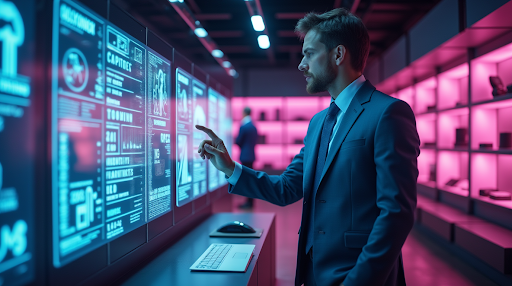Leveraging Headless Commerce for Seamless Tech Integration


The Headless Revolution: Rewiring Retail's Digital DNA
E-commerce content management is undergoing a transformation—no, scratch that—a revolution. The old ways of managing content just don’t cut it anymore. Consumers are demanding faster, more personalized experiences, and traditional platforms are being pushed to their limits.
Enter headless commerce—a flexible, API-driven architecture rewriting the rules and making traditional CMS platforms look like a ZX Spectrum trying to compute Bayesian probabilities in a contest with a quantum computer! The gap in agility, adaptability, and speed is staggering.
In this article, we’ll explore how headless commerce, combined with emerging technologies like AI, AR/VR, and voice interfaces, isn’t just keeping up—it’s pushing the boundary lines of possibility into the distance. From personalizing experiences with AI to creating immersive environments with AR and VR, headless commerce is your secret weapon for e-commerce dominance in the mid-2020s and beyond.
Unlocking Seamless Commerce: The Power of Headless
So, what is a headless content management system (CMS), and why does it matter? Think of it as your brand’s digital chameleon—a flexible, future-proof way to deliver content across any platform without sacrificing user experience.
Traditional CMS platforms struggle with scaling and adapting to multi-platform experiences. Their tightly coupled front and back ends make updates slow and cumbersome. In contrast, headless architectures separate the two, enabling faster content adaptations. This approach keeps your content management agile, polished, and consistent across any platform, even as technology evolves.
Headless architectures don’t try to stuff an elegant shopping journey into an ill-fitting template. They adapt, seamlessly merging and personalizing content to create immersive, fluid experiences across platforms. Whether customers engage via desktop, app, AR/VR headset, or even a smart fridge, a headless approach ensures the experience is perfectly tailored to the device.
Fueling the Shift: How Emerging Technologies Are Rewriting the Rules

Driving the Shift
With AI blazing a trail, emerging technologies are revolutionizing e-commerce and driving rapid innovation. New paradigms are reshaping how businesses manage data and scale operations. Key drivers of these changes include:
- Increasing Data Volumes: AI’s advanced data analysis capabilities allow businesses to process and extract insights from massive e-commerce datasets far faster than humans. With data volumes expected to grow by 33% next year, reaching around 200 Zettabytes in 2025.
- Growing Personalization: A generation that has grown up on digital experiences increasingly expects their content to be personalized. AI enables businesses to deliver tailored recommendations and customized experiences.
- Operational Efficiencies: According to a recent McKinsey report, generative AI and automation transform operational efficiency. For example, AI-powered customer service increased issue resolution by 14% per hour while reducing handling times by 9% and enhancing overall agent productivity.
- Enhanced Customer Experience: AI-powered tools, such as chatbots, are revolutionizing e-commerce interactions. Retail consumers are projected to spend over $142 billion via chatbots in 2024.
- Predictive Analytics: AI’s ability to forecast trends and behavior is driving increasing adoption across various industries, improving the accuracy of business decisions.
- Scalability: Cloud-based headless CMS solutions allow businesses to implement and scale more efficiently and cost-effectively, ensuring adaptability in a rapidly evolving market
AI: Transforming Personalization and Immersion
A report commissioned by Talon. One of 400 senior IT & tech leaders in B2C retail found that 65% already use AI for personalization tasks, and another 30% are actively exploring its capabilities.
Today, it’s no longer just about recommending products—AI is advancing to anticipate customer needs before they even arise. Virtual shopping is becoming increasingly interactive and immersive, allowing customers to engage with products in a more tangible way, all from the comfort of their homes.
Sensing the Future: AI Assistants That See, Hear, and Act
Voice interfaces are evolving rapidly, with new versions of virtual assistants like Siri and Alexa now powered by multimodal LLMs like OpenAI's ChatGPT and Google's Gemini. These tools are on the verge of handling complex, multi-step tasks with greater contextual awareness.
Meanwhile, developments in eye tracking, gesture recognition, and wearables are accelerating, bringing us closer to AI personal assistants that genuinely understand our preferences and act on our behalf. With new iterations of virtual assistants like Siri and Alexa, these multimodal AI systems will soon be able to transact, code, compose, and even create—revolutionizing how we interact with technology.
IoT: Building a Smart, Connected World
Behind the scenes, IoT devices are quietly building the infrastructure of an innovative, connected ecosystem. No longer just gadgets, IoT has become the backbone of an interconnected world where devices communicate and act autonomously. These technologies, from self-driving cars to smart home sensors, create a seamless, intuitive experience for consumers.
When combined with headless commerce, IoT allows businesses to engage customers in real-time across multiple touchpoints, offering personalized interactions wherever they are.
Blockchain: Securing the Future of Digital Commerce
While AI and IoT push the boundaries of innovation, blockchain secures the foundation. By decentralizing data across a network of nodes, blockchain guarantees tamper-proof transactions, offering transparency and security in an era of frequent data breaches.
Beyond security, blockchain streamlines operations by cutting out intermediaries and reducing transaction costs. In headless commerce, blockchain ensures secure, trustworthy interactions and simplifies cross-border payments, making global transactions more efficient and reliable.
Here to Help: The Tangible Benefits of Headless Commerce
Customer Experiences on Steroids
In the age of wild innovation, platform sprawl, and a demand for instant gratification, headless commerce unifies these fragmented experiences. Headless platforms enable quick iteration and deep personalization by seamlessly bridging the gap between browsing and buying, transforming the entire retail content experience. This empowers companies to build the omnichannel future while delivering the speed and customization consumers expect.
Future-Proofing Your Business
As new channels emerge, headless architecture enables businesses to integrate them seamlessly without needing a costly, system-wide overhaul. Those who adapt quickly will survive and thrive in the evolving digital landscape.
Streamlined Content Creation
Consistency across markets is essential for global brands and headless commerce centralizes content creation to ensure brand coherence across every touchpoint. For example, Scotiabank successfully streamlined multi-region messaging while allowing local teams the flexibility to adapt to regional nuances.
Technical Upgrades and Flexibility
Headless commerce is often labeled "game-changing" due to its modular structure that allows easy integration with third-party services, APIs, and tools. This flexibility lets your e-commerce platform easily connect with marketing, CRM, and analytics systems, giving you the freedom to experiment with new features, layouts, and designs—all without interrupting the core functionality of your site.
Scalability and Performance
While scalability is a shared benefit, it's worth emphasizing. Headless commerce lets your platform scale effortlessly as traffic and volume increase without sacrificing performance.
It also enables developers and marketers to easily manage omnichannel experiences and experiment with new technologies, such as AI, AR/VR, and IoT.
Real-World Examples of Headless Commerce in Action
Nike
Nike adopted a headless architecture to optimize its mobile shopping experience, enabling faster load times, personalized experiences, and a seamless cross-platform journey. This move helped Nike gain market share against competitors like Adidas.
Source: Nike’s Headless Commerce Success
Target
Target implemented headless commerce to provide a cohesive cross-device experience. Customers can start shopping on one device and finish on another, resulting in increased website conversion rates and a more unified customer journey.
Source: Target’s Headless Journey
Walmart
Walmart integrated voice commerce with Google Assistant using a headless platform, allowing customers to reorder groceries via voice commands. This streamlined user experience boosts customer satisfaction and retention.
Source: Walmart’s Voice Commerce
Culver’s
Culver’s, one of the biggest fast-food restaurants in the U.S., modernized its website architecture with Agility CMS after experiencing slow loading times and frequent crashes. By switching to a headless approach, Culver’s saw a 50% increase in loading speed and a 26% increase in online orders while eliminating downtime. This shift allowed Culver’s to scale operations while delivering a faster, more reliable user experience.
Source: Culver’s Headless Case Study
Under Armour
Under Armour uses a headless progressive web application (PWA) to enhance user experiences, providing faster, fluid experiences across both mobile and desktop. This headless architecture has led to increased revenue and customer retention.
Source: Under Armour’s Headless Strategy
The Future of Headless Commerce

As e-commerce continues to evolve, headless commerce will remain at the forefront, driven by emerging technologies like AI, blockchain, and IoT. Here’s what the future holds:
- Predictive Commerce: AI will evolve from reactive to truly predictive, foreseeing customer needs with even greater accuracy. Generative AI and personalization technologies will deliver finely tuned marketing, sales, and service experiences for each customer.
- Ethical AI: As data privacy concerns grow, brands that balance personalization with transparency will win consumer trust. Those that integrate ethical AI practices will retain loyalty in an era when safeguarding personal data is a must.
- Green Commerce: Environmental responsibility will become a key differentiator. Headless systems will help brands optimize supply chains, cut emissions, and meet consumer demand for sustainability, positioning eco-conscious businesses to thrive.
- Hyper-Personalization: AI-driven experiences will evolve from one-size-fits-all to entirely bespoke, and future commerce will be able to deliver a level of customization that was once considered science fiction.
The Imperative for Action
Headless commerce offers retail brands much more than a technology upgrade. Today's high-speed market and tomorrow's hypersonic global bazaar need an architecture that provides a path toward clean, frictionless design and integrated scalable omnichannel delivery, and headless commerce offers it. Headless commerce is no longer a luxury but a necessity for staying competitive.
For business leaders, the question isn’t whether they should adopt headless commerce but how quickly they can make the leap. Those who embrace it will lead the next era of digital retail. Those who hesitate will be left behind. The future of e-commerce is headless, and the time to act is now.

About the Author
Adam is an experienced marketing leader with a natural curiosity about human behaviour. He heads up Agility's marketing efforts, helping others discover and experience the easy to use CMS with insane support. A big believer of living in the moment, Adam doesn't want to see you wasting the precious time you have on this earth on clunky, outdated content management systems. He's been there. It wasn't pretty. Give Agility CMS a try and start enjoying your life while you rock your job and have less headaches. Learn more about Adam HERE



